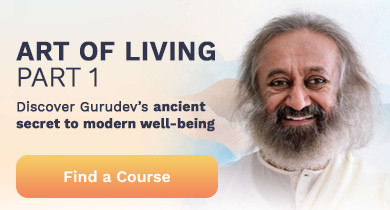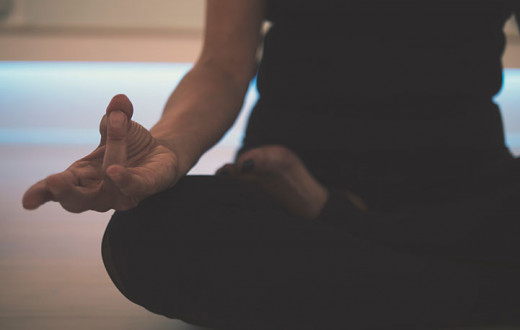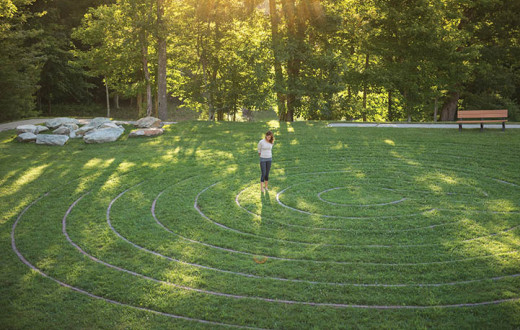By Denise Everheart | Posted : August 28, 2020
Music is often the backdrop to our lives from car radios to movie soundtracks. Music can transform our mental state and transport us to other places, both from our memories and even to imagined other worlds. But are there benefits of meditating with music? Along with looking at the pros and cons of meditation with music, let’s explore how music can genuinely benefit your meditation practice so you can choose.
One of the primary reasons we all meditate is to go inward and shut out the external world for a while. As we sit and close our eyes for that inward journey, we might need assistance in settling into a calm meditative state. Tips and tools for meditation range from simple breathing techniques like straw breath and ujjayi breathing to reminding ourselves of the 3 golden rules. But music can also be a tool for meditation.
Listening
When I think of listening to music for meditation, two kinds of listening come to mind. Often a guided meditation will have some soothing music in the background, sometimes seemingly off in the distance. Here the mind isn’t so much engaged with the music. The music fills the space ever so gently, almost as a buffer to other possible outside noises. This use of music for meditation is very effective and doesn’t hinder you so much from going into a deep meditative state. The second way of listening to music for meditation is more about having your attention on the music itself and merging with the music. Although very pleasant, this method tends to keep the mind on the level of thoughts and therefore doesn’t as easily allow the mind to transcend.
Instrumentation
Some instruments are better suited for creating that meditative space we seek. Here are some that work well.
Flute. Whether it is a bamboo flute or a silver one, a flute might be the most often used instrument for meditations as it is universally calming. Try this beautiful selection called Dissolve by meditation expert Philip Fraser playing a bamboo flute.
Bells. Here’s a nice example of how bells can be used for meditation, with intermittent bells, Tibetan Meditation Bell.
String instruments. One of the very best string instruments for meditation and general relaxation is the harp. Try this Healing and Relaxing Music for Meditation featuring the harp.
Harmonium. The harmonium is an instrument originating from India and looks like a combination of a keyboard and an accordion. Here’s a wonderful example of Meditation Music with Harmonium.
Tibetan singing bowls. Also from Tibet like the Tibetan bells, are the singing bowls often used in yoga studios. Try this 10 Minutes Calming Music to experience a relaxing meditation.
Drums. This percussionist instrument may not be the first to come to mind when thinking of meditation. But here are two examples, one Native American Drum Meditation and the other an Indian Tabla Meditation Music for relaxation and positive healing.
All of these can help a busy mind settle down for a better meditation experience, especially if you are a beginner. Just make sure you keep the volume not too high, maybe place the speaker on the far side of the room to soften the experience. These being excellent examples of ambient music, maybe minus the drums, also serve as wonderful background music for keeping stress levels at bay.
Music with mantras to calm the mind
Vedic mantras are ancient, sacred sounds with vibrational effects when heard, spoken, or thought of that allow your mind to dissolve and repose. Some mantras are sung in the form of bhajans in Sanskrit, in the style of call and response, or kirtan. What is remarkable about music with mantras is their vibrational qualities and influence on our physiology and mental wellbeing. Singing these ancient sounds often accompanied by various instrumentation can also be a tool for meditation. Here are 4 examples of music with mantras.
Om Namah Shivaya. This mantra is one of the most powerful mantras that can be used during challenging times, with or without music, and has a soothing effect on your whole system as well as the environment. Om is an ancient sound that emanates peace. Namah consists of two sound components, Na is associated with the earth element and the first chakra (energy center). Mah is connected to the water element and the second chakra. Shivaya has three sound components. Shi relates to the fire element and the third chakra. Va is the air element and the fourth chakra. Ya is connected to the space element and the fifth chakra. Om contains all the chakras but is especially connected to the crown chakra, the top of the head.
This recorded version of Om Namah Shivaya is also a ‘pranayama’, breathwork that controls the number of breaths per minute. It is led by Gurudev Sri Sri Ravi Shankar, founder of the Art of Living Foundation. See if you know which instrument is in the background as you sing and breathe along.
Devi Kavacham. This beautiful chant referred to as ‘spiritual armor’ is the perfect example of music with mantras where there is literally nothing to do, just listen and allow the vibrational qualities of Devi Kavacham wash over you like a sound bath.
Radhe Govinda. Well-known kirtan musician, Krishna Das, uses ‘call and response’ for this bhajan that stirs the heart. Singing along or sitting and listening, Radhe Govinda can have a profound effect on your consciousness.
Krishna Govinda. Just for fun- try the band, So What Project’s music with mantras Krishna Govinda. So What Project created and popularized Yoga Raves, parties that feature yoga, music with ancient mantras, dance, and meditation. How does a rocking bhajan bring you to a calm meditative state? Ecstatic dancing! Sing and dance like no one is watching, then sit with your eyes closed and enjoy a peaceful meditation.
Meditating with music
Although there are undoubtedly many benefits of using music for meditation, depending upon your meditation goals and level of experience, some guidelines would be helpful. Here are three reasons when it makes the most sense to use meditative music.
You’re a newbie. Using relaxing music to start a new meditation practice makes a lot of sense, especially if you are using a guided meditation that helps lead the mind into meditation itself. Remember earlier when I mentioned music could take us to other worlds? The pitfall here is that sometimes music can cause us to think more rather than less. If you find yourself having a ‘thought’ fest, you may want to consider other options for your meditation practice.
You can’t sit still. If too much tension, anxiety, or fidgeting is an issue, music, whether classical or other instrumental music can give you the beginning stages of relaxation and better prepare you for meditation. You might want to consider using a meditation app like Sattva, which has a large library of music with mantras that you can also set the amount of time you want to listen. Using a timer limiting the time you are dependent upon using music for meditation may actually lead to more independence and a deeper meditation experience overall.
Bonus tip: Try some yoga before sitting for meditation or better yet learn SKY Breath Meditation, a breathwork-based meditation practice for a deep and profound experience of inner peace that also has 100+ studies on the health benefits.
You don’t have your own meditation technique. Mantra music and other meditative music can in no way substitute the power of having a personal mantra given to you by a trained meditation instructor. This is a meditation technique of a higher caliber yielding greater benefits ranging from stress relief to personality development and so much more. To learn more about a mantra-based meditation technique, Sahaj Samadhi Meditation, click here.
Conclusion
Meditation with music, with or without ancient mantras, can be helpful in healing ourselves and definitely increase relaxation, but we should at some point just let go and spend some time in stillness, embracing silence. In more than 40 years of using an effortless, mantra-based meditation technique and 25 plus years of practicing SKY Breath Meditation, I rely on my mantra and my breath for the vast majority of my meditation needs. And for a different experience, occasionally I enjoy meditating with music! Now you can choose how you want to meditate, with or without music, to the beat of your own drum!
For more information about what is taught in SKY Breath Meditation, you can join a FREE, live online session, Beyond Breath, with a meditation instructor.
Denise Everheart is a freelance writer, meditation coach, and recipe designer. Follow her @everheartstudio4meditation and @celeplateyourlife on Instagram.





























